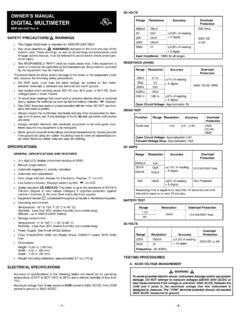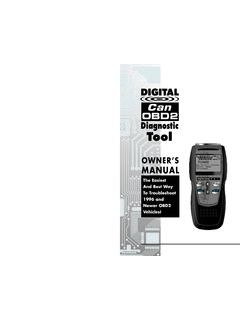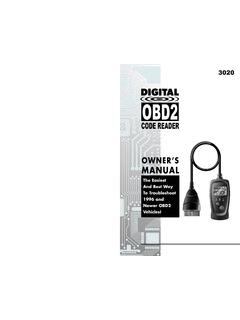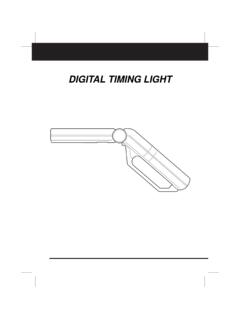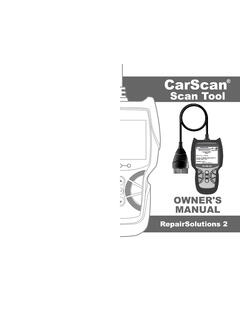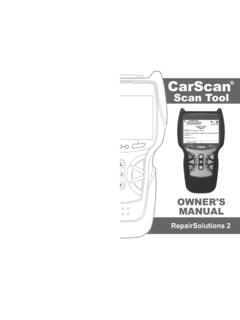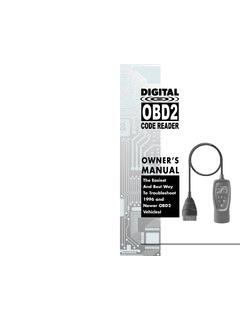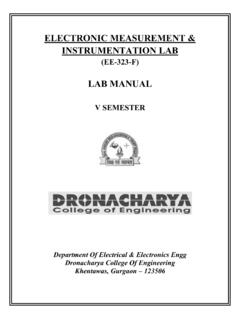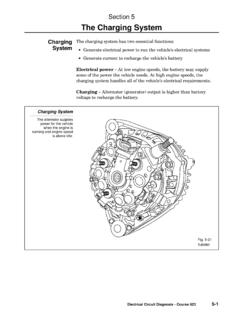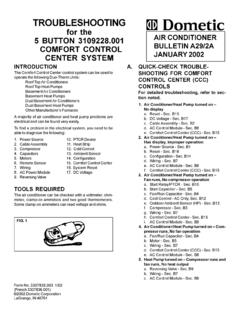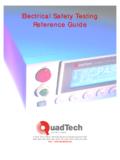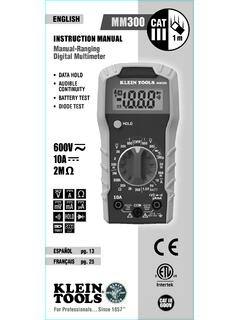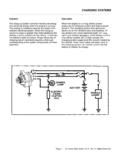Transcription of Table of Contents
1 Table of Contents i Title Page No. INTRODUCTION 1 SAFETY PRECAUTIONS / WARNINGS 2 CONTROLS AND INDICATORS 4 PREPARATION AND CAUTION BEFORE USE 5 TESTING PROCEDURES 6 A. AC/DC voltage MEASUREMENT 6 B. RESISTANCE MEASUREMENT W (OHMS) 6 C. DIODE TEST 7 D.
2 continuity TEST 8 E. AC/DC CURRENT MEASUREMENT (AMPS) 8 F. BATTERY TEST 10 BATTERY AND FUSE REPLACEMENT 11 MAINTENANCE 11 SPECIFICATIONS 12 ELECTRICAL SPECIFICATIONS 13 SERVICE PROCEDURES 17 Introduction 1 INTRODUCTION Congratulations. You have purchased a precision instrument manufactured to the highest quality standards. This Digital Multimeter is a general-purpose instrument designed for use in general electronics, home electrical applications, and auto-motive electrical/electronic systems.
3 This meter is designed to test or measure AC voltage , DC voltage , batteries, DC current, AC current, resistance, diodes and continuity . Please take the time to read these operating instructions thoroughly and completely. Failure to follow these instructions may result in electrical shock, instrument damage and/or damage to the equipment under test. Always use extreme caution when working on or around electrically operated equipment. Safety Precautions / Warnings 2 SAFETY PRECAUTIONS/ WARNINGS Do not operate this multimeter before reading this manual in its entirety.
4 The following guidelines must be followed to avoid accidents that can result in electric shock or personal injury. Pay close attention to WARNINGS stamped on the front and rear of the meter's case. These warnings, as well as all warnings and precautions used through out this manual, must be followed to avoid electric shock and/or personal injury. The RESPONSIBLE PARTY shall be made aware that, if the equipment is used in a manner not specified by the manufacturer, the protection provided by the equipment may be impaired.
5 Before using any of the functions on this meter, verify its proper operation on a known similar function source where the unit value is also known. Take corrective action based on the indicated results. To prevent electrical shock and/or damage to the tester or the equipment under test, observe the following safety precautions: DO NOT apply more than the rated voltage , as marked on the meter, between terminals or between any terminal and earth ground. Use caution when working above 30V AC rms, 42 V peak, or 60 V DC. Such voltages pose a shock hazard.
6 To avoid false readings that could lead to possible electric shock or personal injury, replace the batteries as soon as the low battery indicator displays. Always inspect the multimeter, test leads and any other accessories for damage prior to every use. If any damage is found, do not use tester until repairs are done. Always consider electrical and electronic equipment to be energized (live). Never assume any equipment is de-energized. Never ground yourself when taking electrical measure-ments.
7 Isolate yourself from ground by using dry rubber insulating mats to cover all exposed/grounded metal. Stand on rubber mats and wear dry clothing. Never take resistance measurements on energized (live) electrical or electronic equipment. Use one hand, instead of two, whenever possible to take measurements. If two hands must be used, use extreme caution not to contact any energized conductors with your hands. Be certain test leads are dry and clean. Safety Precautions / Warnings 3 Do not hold the instrument when taking measurements.
8 Place the instrument on a clean, insulating surface prior to taking any measurement. Don't become part of the circuit. Think safety. Act safely. If working on a vehicle, take the following added precautions: Only work on vehicle in a well ventilated area. Always wear safety eye protection. Avoid moving fan blades or any potentially moving parts. Avoid hot engine parts. Put transmission in "park" (automatic transmission vehicles) or "neutral" (manual transmission vehicles). Set the parking brake. Turn the ignition "off" before connecting or disconnecting any testing equipment.
9 Put blocks on drive wheels. Avoid wearing loose clothing or jewelry when working on a vehicle. Read your vehicle's service manual and follow it's safety procedures. Controls and Indicators 4 CONTROLS AND INDICATORS 1. DCV Function: Measures DC volts. Auto-ranging from 0 to 600 volts (10 MW impedance) 2. ACV Function: Measures AC volts. Auto-ranging from 0 to 600 volts (10 MW impedance) 3. Resistance Function: Measures resistance. Auto-ranging from 0 to 20MW (20,000,000W).
10 4. ACmA Function: Measures AC current in milliamps. One range: 0 to 200 milliamps. 5. DIODE Function : For testing diodes. 6. continuity Function : Tests for continuity between two points. 7. Volts, mA, OHMS, BAT, DIODE and continuity Input Jack. 8. COM Input Jack: Common Input Jack. 9. DC10A Input Jack: For red test lead probe connection when measuring high DC current (up to 10 amps only). 10. DC10A Function: Measures DC current. One range: 10 Amps (DC from 0 to 10 amperes). Unfused. 11. DCmA Function: Measures DC current in Milliamps.
